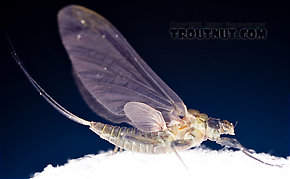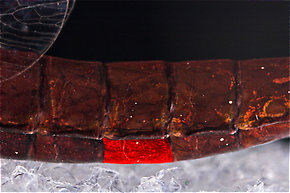Blog & Latest Updates
Fly Fishing Articles
Insects by Common Name


> > Anyone recognize this Drunella?
The Specimen
Drunella tuberculata Mayfly Dun View 14 PicturesI don't know for sure that this is Drunella tuberculata, but that's my best guess for now.
View 14 PicturesI don't know for sure that this is Drunella tuberculata, but that's my best guess for now.
It certainly has a different look and much more robust body shape from Drunella lata duns I photographed a couple weeks earlier, so I doubt it's that species. Using distribution records to eliminate other choices narrows this down to Drunella tuberculata or Drunella walkeri.
Markings described for the abdominal sternites ( Sternite: The bottom (ventral) part of a single segment on an insect's abdomen.) of the male spinner of Drunella tuberculata are suspiciously similar to those on this female dun. Also, this dun is 9.5mm long (my ruler pic isn't very good, but I'm basing this on measuring the real thing). The size range given in the old Allen & Edmunds keys for walkeri females is 7-8mm, while tuberculata is 9-11mm. For these reasons I'm sticking it in tuberculata for now.
Sternite: The bottom (ventral) part of a single segment on an insect's abdomen.) of the male spinner of Drunella tuberculata are suspiciously similar to those on this female dun. Also, this dun is 9.5mm long (my ruler pic isn't very good, but I'm basing this on measuring the real thing). The size range given in the old Allen & Edmunds keys for walkeri females is 7-8mm, while tuberculata is 9-11mm. For these reasons I'm sticking it in tuberculata for now.
This is the only Drunella mayfly I saw all day. I scooped it off the water as it emerged at around 7pm from a big Catskill tailwater.
 View 14 PicturesI don't know for sure that this is Drunella tuberculata, but that's my best guess for now.
View 14 PicturesI don't know for sure that this is Drunella tuberculata, but that's my best guess for now. It certainly has a different look and much more robust body shape from Drunella lata duns I photographed a couple weeks earlier, so I doubt it's that species. Using distribution records to eliminate other choices narrows this down to Drunella tuberculata or Drunella walkeri.
Markings described for the abdominal sternites (

One sternite of this Isonychia bicolor mayfly spinner is highlighted in red.
This is the only Drunella mayfly I saw all day. I scooped it off the water as it emerged at around 7pm from a big Catskill tailwater.
Collected June 1, 2007 from the West Branch of the Delaware River in New York
Added to Troutnut.com by on June 8, 2007
Added to Troutnut.com by on June 8, 2007
The Discussion
| Troutnut | June 8th, 2007, 2:52 pm | |
Administrator Bellevue, WAPosts: 2737 | I'm a bit puzzled about this one. See the specimen description for details. I know female duns are awful for identification, but this is the only one of its species I could find. Would any of you Ephemerellid experts (Konchu!!) care to take a guess? | |
| Jason Neuswanger, Ph.D. Troutnut and salmonid ecologist | ||
| GONZO | June 8th, 2007, 3:58 pm | |
Site Editor "Bear Swamp," PAPosts: 1681 | Could be tuberculata, but distinguishing between that and walkeri is something I'll leave in Konchu's capable hands. However, I don't think that the size difference suggested by Allen and Edmunds is valid. | |
| Troutnut | June 8th, 2007, 4:01 pm | |
Administrator Bellevue, WAPosts: 2737 | I don't think that the size difference suggested by Allen and Edmunds is valid. You're probably right. That's a pretty outdated paper. It's just the best hint I've got to go on for now. | |
| Jason Neuswanger, Ph.D. Troutnut and salmonid ecologist | ||
| GONZO | June 8th, 2007, 5:07 pm | |
Site Editor "Bear Swamp," PAPosts: 1681 | I just reread Konchu's paper on the Drunella revisions, hoping to find something more definitive. It mostly helped to confirm that distinguishing between tuberculata, walkeri, and allegheniensis is very difficult due to variability. I suppose it's appropriate to rule out allegheniensis based on distribution. I also thought that the early hatch date might rule out walkeri, but apparently there can be wide discrepancies between different groups or cohorts even within the species. (And an evening Drunella emergence is something I've only witnessed on the Delaware.) | |
| Konchu | June 9th, 2007, 6:03 am | |
Site Editor IndianaPosts: 505 | Too early in the morning to put a species name on that specimen. Walkeri/tuberculata are likely candidates. I'd lean towards walkeri, but I'd never put it in writing on a det label. | |
| Troutnut | June 9th, 2007, 8:19 am | |
Administrator Bellevue, WAPosts: 2737 | What do you guys think of the protrusion below the right eye on the second picture down? That's an interesting feature in a dun. | |
| Jason Neuswanger, Ph.D. Troutnut and salmonid ecologist | ||
| GONZO | June 9th, 2007, 8:27 am | |
Site Editor "Bear Swamp," PAPosts: 1681 | It appears to have lost its righthand antenna, so I took that protrusion to be the healed remains. Perhaps the damage occurred in an earlier larval stage. | |
| Taxon | June 9th, 2007, 9:32 am | |
Site Editor Royse City, TXPosts: 1350 | Anyone know on which lifestage(s) and anatomic location(s) the tubercle(s) (for which this species in named) appear(s)? Once Jason got me looking closely at the second photo, I couldn't help but wonder about that interesting midline nodule on top of the head, or perhaps the pronotum. | |
| Best regards, Roger Rohrbeck www.FlyfishingEntomology.com | ||
| GONZO | September 21st, 2009, 2:53 pm | |
Site Editor "Bear Swamp," PAPosts: 1681 | Konchu's mention of D. tuberculata in the Smokies led me back to this old thread and Roger's question about the etymology of the name. Anna Haven Morgan originally described the species from a nymph found in the upper part of Fall Creek near Ithaca, NY. Although she didn't explain the etymology, she did refer to "two large erect tubercles on the occiput" of the head, and she also illustrates these in her paper. | |
Quick Reply
You have to be logged in to post on the forum. It's this easy:
Related Discussions
| Title | Replies | Last Reply |
| Re: species taxonomy In the Mayfly Genus Caudatella by Konchu | 3 | Oct 30, 2010 by Taxon |
| Re: Drunella grandis species complex In the Identify This! Board by Crepuscular | 2 | Aug 2, 2019 by Crepuscular |
| Re: Thoughts In Male Eurylophella Mayfly Spinner by Taxon | 5 | Mar 7, 2013 by Entoman |
| Re: Drunella in the Smokies In the Mayfly Species Drunella tuberculata by Konchu | 6 | Jan 4, 2010 by Konchu |
| Re: October Ephemerellid In the Identify This! Board by Crepuscular | 15 | Oct 22, 2013 by Entoman |
| Re: Ephemerella nymph In Ephemerella aurivillii Mayfly Nymph by Millcreek | 1 | Sep 26, 2020 by Troutnut |
| Re: Fallceon species mating In General Discussion by Millcreek | 7 | Dec 1, 2015 by Millcreek |
| Re: Help With Identification In the Identify This! Board by Redadman | 3 | May 1, 2020 by Martinlf |
| Re: Flightless Mayfly?? In the Mayfly Genus Serratella by ZenCane | 8 | Apr 5, 2010 by Gutcutter |
| Re: Ephemerella maculata (1 more) In the Photography Board by Millcreek | 3 | Apr 12, 2015 by PaulRoberts |
Troutnut.com is copyright © 2004-2024 Jason
Neuswanger (email Jason). See my FAQ for information about use of my images.
 privacy policy
privacy policy



